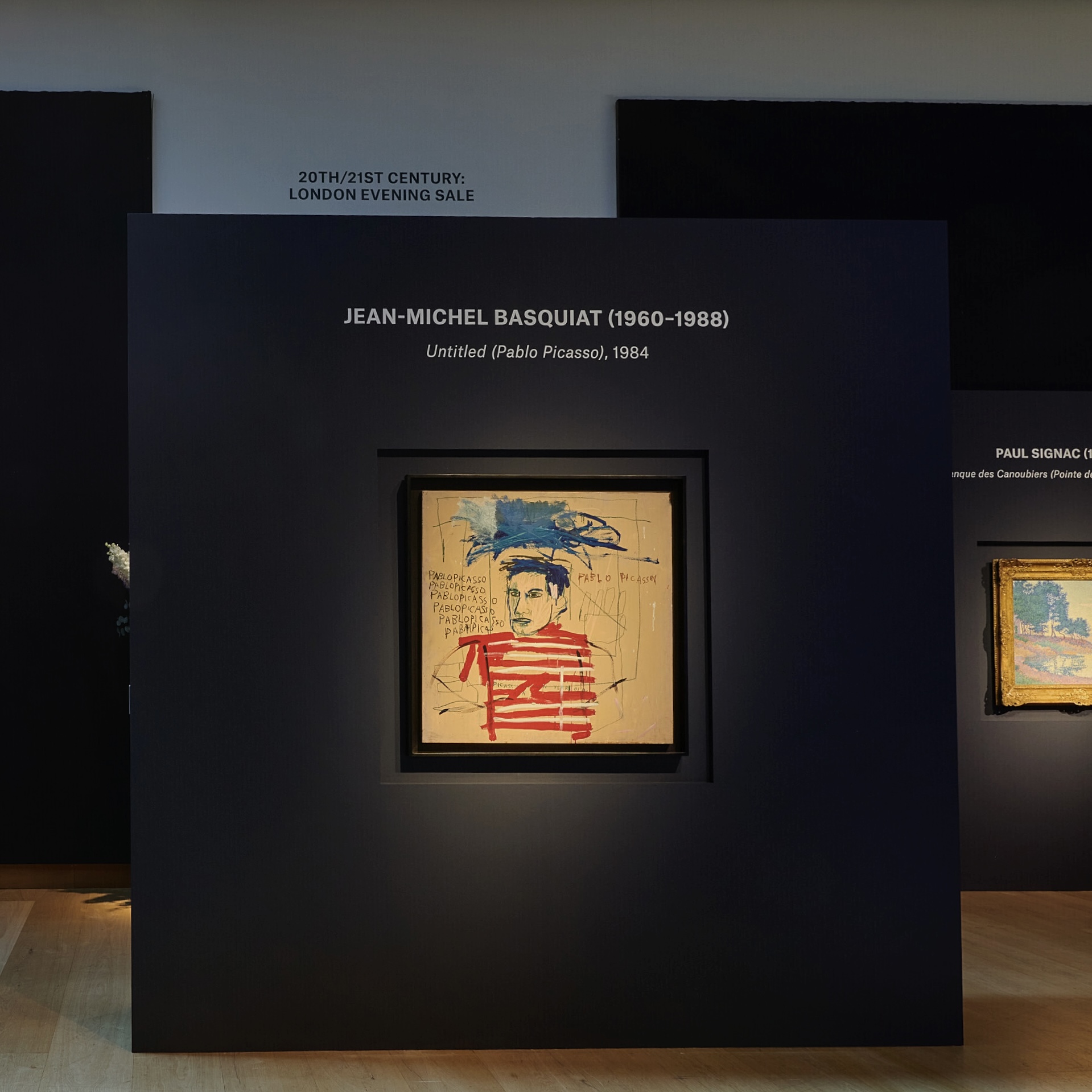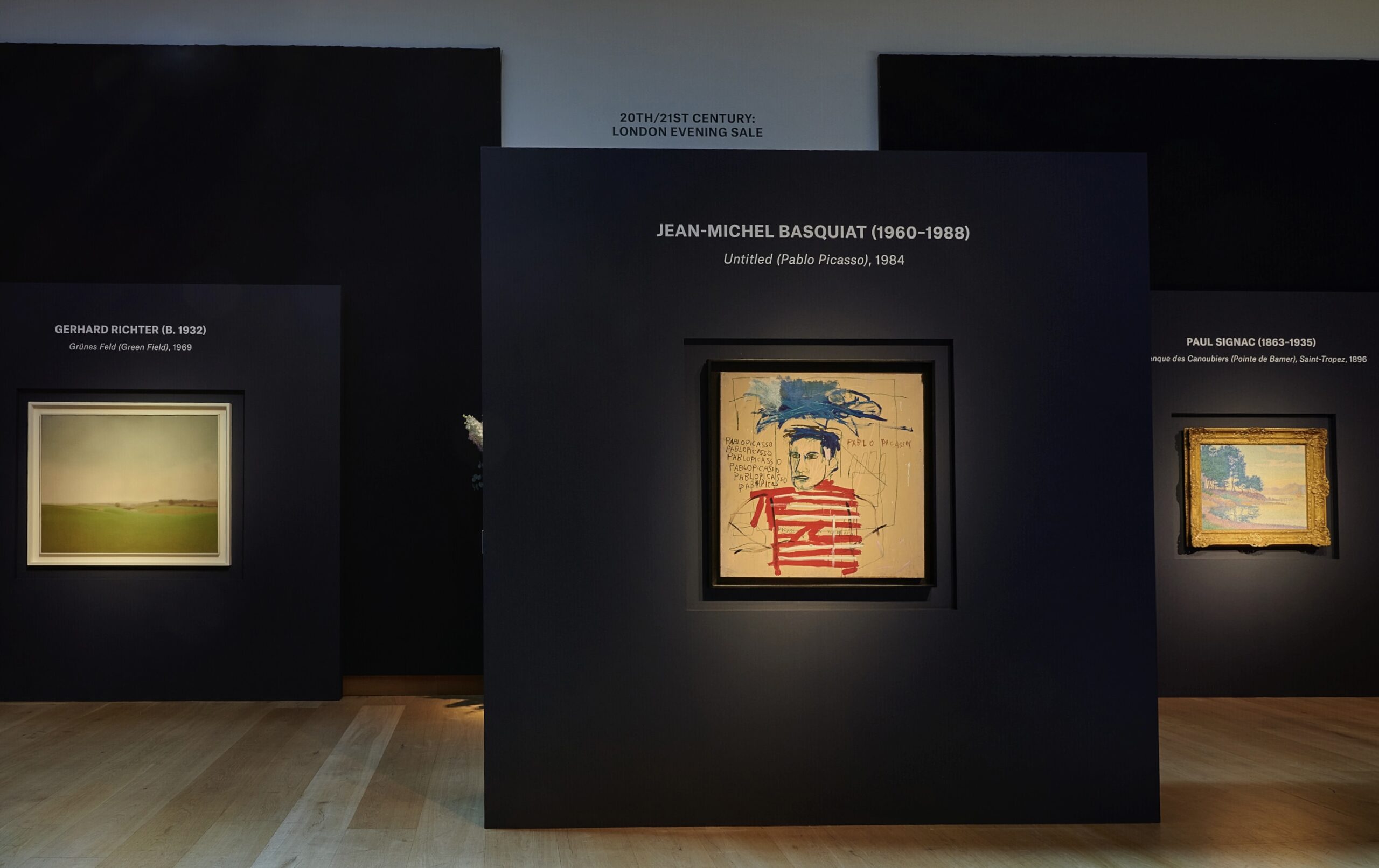
Jean-Michel Basquiat (America, 1960-1988)
Untitled (Pablo Picasso)
acrylic and oil stick on metal
35 5/8 x 35 5/8in. (90.5 x 90.5cm.)
Executed in 1984
Price Realised GBP 6,462,500 at Christie's London, 28 June 2023

Included in the 2017-2018 retrospective Basquiat: Boom for Real at the Barbican Gallery, London, Untitled (Pablo Picasso) (1984) is a bold tribute from one twentieth-century titan to another. Painted and drawn in oil, acrylic and oilstick on a square metal panel, Basquiat’s Picasso emerges in vivid colour. His trademark striped shirt is a stack of red and white brushstrokes, bright against the buff-coloured backdrop. Delicate black and green oilstick shades his features; pink scrawls bring out the paleness of his skin. Thickets of blue highlight his hair and burst in a storm-cloud above his head, as if picturing the buzz of his mind. The word ‘FAMOUS’ can be glimpsed amid the blue. ‘PABLO PICASSO’ is written seven times like an incantation, and the legend ‘PICASSO AT 15 YEARS / PICASSO AS A FIFTEEN YEAR OLD’ can be seen, partly obscured, on his chest. Basquiat conflates timelines, depicting a youthful Picasso in the iconic Breton-striped guise of his older self. The work is also something of a self-portrait. Basquiat—aged just twenty-three when he made this picture—identifies implicitly with his hero, who also showed extraordinary talent from a young age. Revealing his complex relationships with fame, ambition and Western art history at large, Basquiat considers his own future place among the masters.
Basquiat acknowledged Picasso as one of his most important influences. He recalled Guernica (1937), which was on display at MoMA in New York until 1981, being his favourite artwork as a child. By 1985, he had a small Picasso oil painting in his own collection. Perhaps the first bona fide artist celebrity of the modern era—charismatic, regal and frequently photographed—Picasso was a model in his stardom as well as in his prodigious artistic output. ‘Since I was 17, I thought I might be a star’, Basquiat said. ‘… I’d think about all my heroes, Charlie Parker, Jimi Hendrix … I had a romantic feeling of how people had become famous’ (J-M. Basquiat, quoted in C. McGuigan, ‘New Art, New Money: The Marketing of an American Artist’, The New York Times Magazine, 10 February 1985, section 6, p. 34). His works often memorialised these Black heroes, including boxers, baseball players, and musicians. He blurred their identities with his own. The field of modern painting, however, provided few Black precedents. Basquiat wanted to make his mark in an overwhelmingly white arena.
Basquiat’s young-old Picasso appears to have been based on two different visual sources, likely found in one of his books about the artist. The face derives from a portrait of Picasso taken in 1896, when he was fifteen years old. The Breton shirt became part of Picasso’s image much later, and was immortalised in a famous photoshoot by Robert Doisneau in 1952. Bringing aspects of these two eras into a single persona, Basquiat develops the theme of a work on paper he made in the same year, titled Young Picasso. There, the artist’s youthful and older faces are drawn side by side. The watchful ‘YOUNG PICASSO’ is finely featured in ochre, while the livid red visage of ‘OLD PICASSO’ has been scribbled out. In the present work, the young face is shaded with even greater care, as if Basquiat is trying out one of Picasso’s more naturalistic styles for himself. But it is also heavier than in the drawing. His features are overlaid by dark lines, squaring off the jaw and opening the mouth into a slight grimace. With the cloud of fame hovering over him, this hybrid Picasso seems older than his years, and troubled by the premonition of his greatness.
Basquiat’s attitude towards Picasso was not one of straightforward hero-worship. The Spanish painter’s ‘primitivist’ appropriations of African masks and sculpture—epitomised in Les Demoiselles d’Avignon (1907)—had changed the language of twentieth-century painting. Basquiat was aware of the irony that this story had historically sidelined Black artists. In 1983, Diego Cortez described Basquiat as a ‘Black Picasso.’ Asked later if he liked the comparison, Basquiat replied: ‘Not so much. It’s flattering, but I think it is also demeaning’ (J-M. Basquiat, quoted in L. Licitra Ponti, ‘The House of Jean-Michel’, Domus, No. 646, January 1984, p. 68).
The self-conscious and sophisticated primitivism that Basquiat adopted—toying with the premise that a Black artist should in fact be ‘primitive’—subverted the expectations of the largely white art world in 1980s New York. His use of fragmented, juxtaposed African artistic motifs was necessarily different from Picasso’s. He drew masks, idols and ideograms from books, including the Metropolitan Museum of Art’s collection catalogues, Burchard Brentjes’ African Rock Art (1969) and, from 1983 onwards, Robert Farris Thompson’s Flash of the Spirit: African & Afro-American Art & Philosophy (1983). Loaded with pain, provocation and irony, Basquiat’s works explored his own complex identity as a Black man in America, as well as the wider historical position of Black people. ‘Basquiat was grappling with both the pull of a genealogy that is fundamentally “black” (rooted in African diasporic “primitive” and “high art” traditions) and a fascination with white Western traditions’, writes bell hooks. ‘Articulating the distance separating traditional Eurocentric art from his own history and destiny and from the collective fate of diasporic black artists and black people, Basquiat’s paintings testify’ (b. hooks, ‘Altars of Sacrifice: Re-Membering Basquiat’, Art in America, Vol. 81, No. 6, June 1993, p. 69).
Basquiat’s relationship with Andy Warhol, king of the downtown New York art scene, played out some of these tensions in real time. They were introduced in 1982, and from 1983 to 1985 collaborated on a series of paintings which are widely seen to have brought new life to Warhol’s late career. Basquiat also benefited from Warhol’s reputation and experience, leasing his Great Jones Street loft studio and gaining valuable connections through the older artist. His 1982 painting Dos Cabezas, however—a portrait of the two made at the outset of their association—discloses an uneasy dynamic. Warhol’s countenance looms large, fleshed out in vampiric pallor. Basquiat depicts himself as a comparatively small and one-dimensional presence. The work might be seen to picture what bell hooks calls the ‘narrow Eurocentric gaze … which can only recognise Basquiat if he is in the company of Warhol or some other highly visible white figure.’ Critics who focus on Basquiat’s obsession with fame and glory, she writes, ‘fail to recognise Basquiat’s mocking, bitter critique of his own longing for fame’ (b. hooks, ibid., pp. 68, 71). The scrubbed-out ‘FAMOUS’ at the head of the present painting conveys the same ambivalence.
Artists have long confronted, learnt and departed from the masters of the past as a way of finding their own voice, and Basquiat was far from alone in grappling with the outsized legacy of Picasso. Both David Hockney and George Condo, a fellow Warhol associate during the 1980s, have spent decades exploring Picasso’s ideas in their paintings. Like them, Basquiat engaged with Picasso on a formal and iconographic level, and was inspired by the force of his creative genius. But it is a sense of irreconcilable difference, rather than affinity, that makes the present work so powerful. If Basquiat sees himself in the young Picasso, the overt whiteness of the artist’s skin denies him the ease of identification. He knew that his path to glory would be compromised in ways that Picasso never had to contend with. In Untitled (Pablo Picasso), Basquiat’s inimitable line, energetic colours, and fierce, quickfire intelligence are ultimately their own testament to greatness. He leaves a mark that could belong to no other artist.










